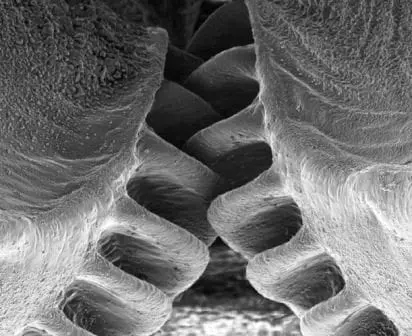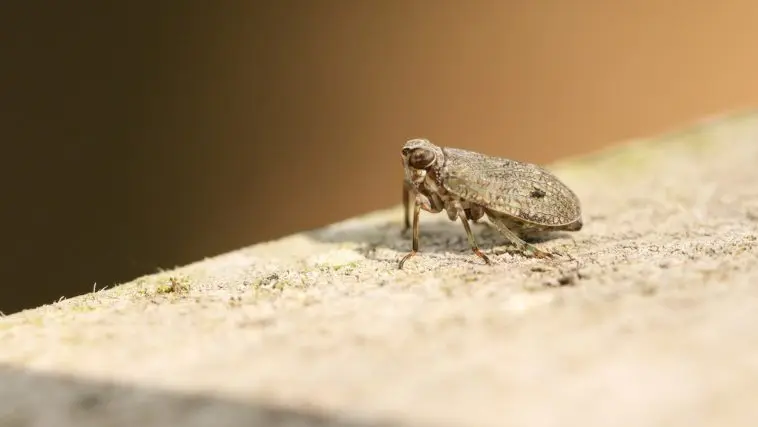[Originally published in 2013 as An Insect with Gears]
The video above shows you the jumping prowess of a juvenile Issus coleoptratus, a species of plant hopper. As its name implies, this insect hops from plant to plant, eating sugar directly from the veins of the plant’s leaves.
Believe it or not, jumping is a rather difficult way to travel, because once you are in the air, you don’t have much control over your body’s movement. As a result, the jump itself is very important. Not only must it be aimed correctly, it must happen so that the body stays upright throughout the time it is in the air.
That latter task can be a bit difficult. Imagine, for example, if an insect pushes off really hard with one leg, but not very hard with the other leg. This imbalance would cause the body to start spinning in the air, which would make for horrible aerodynamics and a very difficult landing!
The same thing would happen if the pushes were not timed very well between the legs. If one leg started pushing sooner than the other, the insect would once again go spinning out of control. Most jumping insects are designed to deal with this by having their jumping legs arranged on either side of the body. This gives them a larger margin of error when it comes to both the timing and the force of each leg. This is convenient, but it also inherently limits how high and far the insects can jump.
For species of insects that must jump really high and far, the legs must be right under the body. This maximizes the amount of force that goes into the jumping motion, but it also allows for only a tiny margin of error in terms of the timing and relative force of each leg. As a result, these species must coordinate their jumping legs very, very precisely.
How does the juvenile Issus coleoptratus synchronize its legs? It uses its built-in gear!

There are two sets of teeth, one on the inside of each leg. When the insect jumps, these teeth lock together as shown in the video above. They click by each other at an incredible rate, and this allows the legs to be synchronized to within 30 millionths of a second!1 As a result, the insect can jump high and true.
Now, this isn’t the first example of something that looks like it was designed by people being found in the natural world. In 2011, scientists reported discovering a screw designed in the leg of the weevil Trigonopterus oblongus.2
While finding gears and screws in the natural world is interesting, I find something else about the gear discovery even more interesting.
This gear is found in the juvenile form of the insect, but it is not found in the adult form. As the insect matures, it molts (sheds its outer covering), and in the last molt into adulthood, the gear design goes away. Of course, the adults still jump, but they use a frictional mechanism to ensure that the legs fire simultaneously and with the same force.3
Why would the gear system go away? According to the authors of the study in reference 1:
An inherent limitation of gears is that if one tooth breaks, their synchronizing action is degraded. In nymphs, a breakage could be repaired at the next molt, but this is not possible after the final molt to adulthood. Alternatively, the larger size of adults may mean that friction between the trochantera is a more effective synchronization mechanism.
I suspect that both issues are at play here.
The gear is an excellent design as long as there is a repair mechanism for the teeth. However, once molting stops (at adulthood), the teeth cannot be repaired, so a different design must be used. Most likely, that design doesn’t work well for small bodies, but once the insect has reached adulthood, it is large enough for the new design to work. Apparently, the new design is better because the adult plant hopper is a better jumper than the juvenile plant hopper!
So when the insect is small, it uses a gear design for jumping. This isn’t the best design for a jumping insect, but it is probably the best design for a small jumping insect. Once the insect gets large enough, the gear design is replaced with a new and better design. What does that sound like to you? To me, it sounds like incredible engineering. Two different designs are used, and each of them is in place when it is most effective.
Of course, that’s not surprising, since these designs come from the Ultimate Engineer!
References
- Malcolm Burrows and Gregory Sutton, “Interacting Gears Synchronize Propulsive Leg Movements in a Jumping Insect,” Science 341:1254-1256, 2013
- Thomas van de Kamp, Patrik Vagovič, Tilo Baumbach, and Alexander Riedel, “A Biological Screw in a Beetle’s Leg,” Science 333:52, 2011
- M. Burrows, “Energy storage and synchronisation of hind leg movements during jumping in planthopper insects (Hemiptera, Issidae),” Journal of Experimental Biology, 213:469–478, 2010







